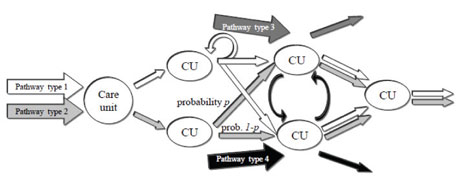by Anke Hutzschenreuter, Peter Bosman and Han La Poutré
With the aging of the population and the demand for cost-efficiency, logistics and planning in hospitals are becoming increasingly important. In many countries, hospitals are organized in a decentralized fashion, with (medical) departments and units having a high degree of autonomy in management and planning. The Agi-Care project (Agent-based intelligent health care planning) develops computational approaches to the optimization of patient flow logistics in hospitals, ie, concerning the various pathways of inpatients moving through various units in a hospital. The Agi-Care project has been carried out at Eindhoven University of Technology, in cooperation with the Catharina Ziekenhuis Eindhoven and Centrum Wiskunde & Informatica (CWI - the Dutch national research centre for mathematics and computer science), in the Netherlands.
Scheduling decisions in hospitals are often taken in a decentralized way. This means that different specialized hospital units make autonomous decisions relating to such issues as patient admissions and schedules of shared resources. Decision support in such a setting requires different methods and techniques to those described in the majority of existing literature, which tends to assume a centralized model. The design and analysis of such methods and techniques is the focus of the project, which is now in its final stages. Specifically, we developed computational models to provide dynamic decision support for hospital resource management and the prediction of future resource occupancy, and we studied the application thereof.
Hospital resource management targets the efficient deployment of resources like operating rooms and beds in various care units (intensive care, medium care, nursing room etc). Allocating resources to hospital units is a major managerial issue as the relationships between resources, their utilization, and the combined pathways of different patient groups through the hospital is complex (see Figure 1).These issues are further complicated by the fact that patient arrivals are dynamic, and treatment processes are stochastic.

Figure 1: Example of various types of patients with their possible pathways through different care units (CU) in a hospital Every pathway type has its own color, where branchings in a pathway of a certain patient type occur with some probability, reflecting the uncertainty in patient treatment within the patient types, and where lengths of stay at a certain care unit are stochastic within a patient type.
Our approach to providing decision support combines techniques from multi-agent systems and computational intelligence (CI). This combination of techniques allows us to properly consider the dynamics of the problem while reflecting the existing distributed decision-making practice in hospitals. Multi-agent techniques are used to realistically model multiple hospital care units and their decision policies, multiple patient groups with stochastic treatment processes, and uncertain resource availability due to overlapping patient treatment processes (see Figure 1). Optimization and learning techniques from CI allow for designing and evaluating improved (adaptive) decision policies for the agent-based model, which can then be implemented easily in hospital practice.
In order to gain insight into the functioning of this complex and dynamic problem setting, we developed an agent-based model for the hospital care units (partly) used by the cardiothoracic surgery (CTS) department, with their different (sub)types of patients. To assess the applicability of this agent-based model, we developed an extensive simulation. Several experiments demonstrated the functionality of the simulation and showed that it is an accurate representation of the real world. The simulation is used to study decision support in resource management and patient admission control.
To further improve the quality of decision support, we studied the prediction of future hospital resource usage. Using these predictions, the future impact of taking a certain decision at a given moment can be taken into account. In the problem setting at hand, for instance, predicting the resource utilization resulting from an admission decision is important to prevent future bottlenecks that may cause the blocking of patient flow and increase patient waiting times. The methods we investigate for the task of prediction are forward simulation and supervised learning using neural networks. In an extensive analysis, we used stochastic techniques to study how accurate and precise prediction outcomes can be obtained.
To optimize resource allocation decisions, we considered multiple criteria that are important in the hospital problem setting. Specifically, we focused on three conflicting objectives to be optimized: maximal patient throughput, minimal resource costs, and minimal usage of back-up capacity (of beds). All criteria can be taken into account by finding decision policies that have the best trade-off between the criteria (‘Pareto optimality’). We derived various decision policies that partly allow for adaptive resource allocations. The form of the policies allows them to be easily understood by hospital personnel. Moreover, we incorporated a ‘bed exchange mechanism’ that enables a realistic implementation of these adaptive policies in practice.
In our optimization approach, the parameters of the different decision policies were determined using a multi-objective evolutionary algorithm (MOEA). The MOEA uses the agent-based simulation in order to evaluate the quality of potential solutions, and it thus optimizes the output of the simulation (ie the three optimization criteria) as a function of the policy parameters. Optimization using the MOEA with its embedded simulations was performed on a high-performance cluster. Our results on resource management showed that the benchmark allocations obtained from a case study are considerably improved by the optimized decision policies. Furthermore, our results showed that the use of adaptive policies can lead to better results and that further improvements may be obtained by integrating prediction into a decision policy.
Anke Hutzschenreuter will defend her Ph.D. thesis that has resulted from this project in the upcoming months.
Links:
http://is.tm.tue.nl/
http://www.cwi.nl/en/research-groups/Computational-Intelligence-and-Multi-agent-Games
Please contact:
Anke Hutzschenreuter
E-mail:
Han La Poutré, CWI, The Netherlands
E-mail:










